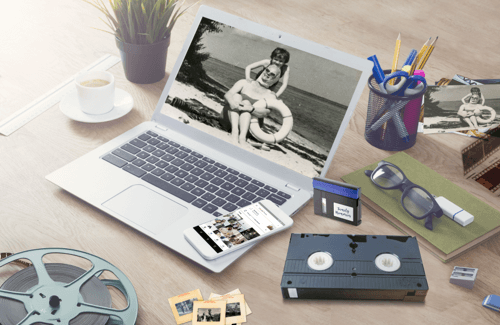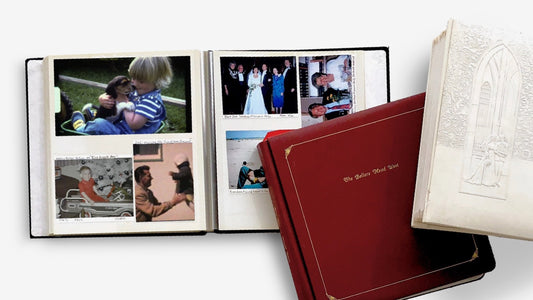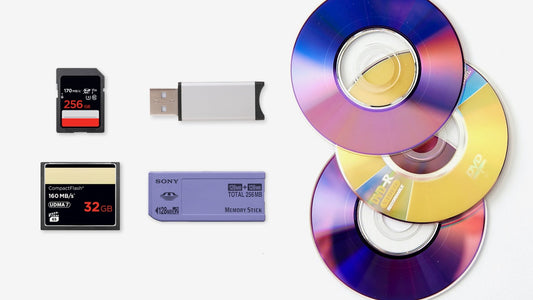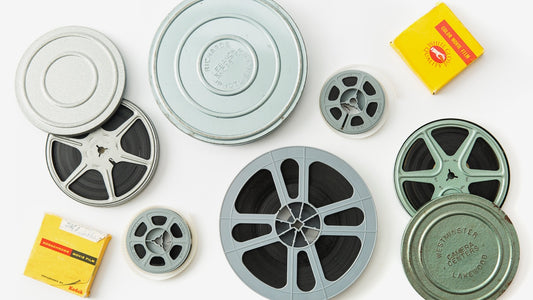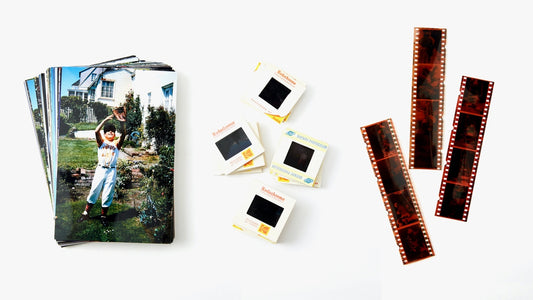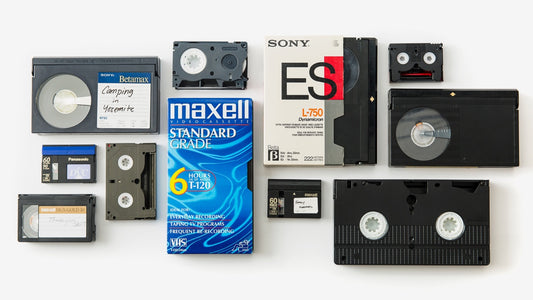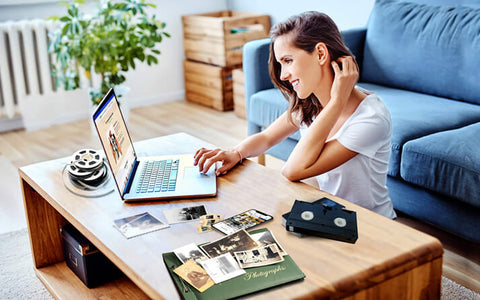Your most cherished family memories—your parents’ wedding, your first steps, that hilarious 80s hairstyle—are likely trapped on formats you can no longer watch. Those moments are meant to be shared and relived, not just gathering dust in an attic. The best way to bring them back into your life is to digitize old home movies, making them as easy to share as a photo on your phone. You can finally send that clip of grandpa’s goofy dance to the whole family or host a movie night with footage no one has seen in decades. This guide will show you exactly how, so you can stop storing your memories and start sharing them again.
Key Takeaways
- Act Before Your Tapes Fade: Physical media like VHS tapes and film reels are actively deteriorating from age and environmental factors. Converting them to digital is the only way to permanently halt this decay and safeguard your family’s irreplaceable moments.
- Choose Your Path: Pro vs. DIY: Your decision should balance time, cost, and desired quality. A professional service offers convenience and superior results with specialized equipment, while the DIY route gives you control if you have the patience and technical setup.
- Store Securely, Share Widely: Once your movies are digitized, protect them by creating backups on both a physical drive and a cloud service. This keeps them safe and makes it simple to relive and share your newly accessible memories with family and friends.
Why It's Time to Digitize Your Home Movies
If you have a box of old home movies tucked away in a closet or attic, you’re holding onto priceless family treasures. Those tapes and film reels capture irreplaceable moments: a first birthday party, a grandparent’s wedding, a silly family vacation. But those memories are trapped on formats that are fading away. Digitizing your home movies is the best way to protect those moments and bring them back into your life so they can be enjoyed for generations to come.
Think of it as moving your memories from a fragile, aging house into a secure, modern home. It’s about safeguarding them from the wear and tear of time and making them easy to relive and share with the people you love most.
Stop Your Tapes from Fading Away
Let's be honest, physical media doesn't last forever. Videotapes, film reels, and camcorder tapes are all susceptible to decay. The magnetic tape in a VHS can degrade over time, with some studies showing they can lose 10-20% of their quality in as little as 10 years. Heat, humidity, and dust can speed up this process, causing colors to fade, sound to warp, and the tape itself to become brittle.
By choosing a video transfer service, you create a high-quality digital copy that stops this deterioration in its tracks. A digital file won't fade or break down. It’s a permanent archive that protects your family’s history from being lost to damage, accidents, or the simple passage of time.
The Lifespan of Analog Media
Understanding that your analog media has an expiration date is the first step toward saving it. Those formats were never meant to last indefinitely. Research shows that the magnetic tape in a VHS can lose 10-20% of its quality in as little as 10 to 25 years. Factors like heat, humidity, and even dust in the air can speed up this process, resulting in faded colors, distorted sound, and brittle tape that can easily snap in an old VCR.
Film reels face a similar deadline. Most 8mm film has a lifespan of about 70 years, meaning many home movies from the mid-20th century are already at high risk of permanent loss. As these formats age, the chemical breakdown becomes irreversible, and those visual memories can be lost forever. The only way to stop the clock is to transfer your film to a digital format. This creates a stable, high-quality copy that safeguards your family’s history from the natural decay of time, ensuring those irreplaceable moments are preserved and ready to be shared with loved ones.
Share Your Favorite Moments Instantly
One of the best parts of digitizing your home movies is how easy it becomes to share them. Finding a working VCR or film projector can be a challenge, but digital files can be played on your computer, TV, or phone with a simple click. You can finally show the kids what you looked like in the 80s or send a clip of your parents’ wedding to your entire family for their anniversary.
As this AARP article explains, digital files give you complete freedom. You can upload them to social media, email them to relatives across the country, or even edit them into new highlight reels. Your memories are no longer stuck in a box; they’re ready to be shared and enjoyed by everyone, anywhere.
What Kind of Home Movies Are You Working With?
Before you can bring your family’s memories into the digital age, it helps to know what you’re working with. Tucked away in attics, basements, and closets are boxes filled with all sorts of media formats, each telling a piece of your story. Identifying them is the first, most important step in the preservation process. You might find a mix of tapes, reels, and even slides, and knowing the difference is key to choosing the right path forward. Most home movies fall into a few common categories, from the chunky VHS tapes of the 80s and 90s to the delicate film reels from decades earlier. Each type has its own quirks, lifespan, and specific needs for conversion. For example, magnetic tapes like VHS are prone to decay and signal loss, while film reels can become brittle and discolored over time. The equipment needed to play these formats is also becoming increasingly rare and unreliable, making now the perfect time to act. Understanding what you have not only helps in planning the digitization project but also connects you more deeply with the history captured on that media. Let’s walk through the most common formats you might find, so you can figure out exactly what treasures you have and how to best care for them.
Digitizing Your VHS and VHS-C Tapes
Remember those big, black plastic rectangles? VHS tapes were the go-to for recording everything from birthday parties to school plays for decades. You might also find their smaller cousins, VHS-C tapes, which were used in compact camcorders. Unfortunately, these tapes weren't built to last forever. They can lose 10-20% of their quality in just 10 to 25 years as the magnetic tape degrades. Plus, finding a working VCR to play them on is becoming a real challenge. A professional video transfer is the surest way to save those precious moments before they fade away completely.
Digitizing 8mm and Super 8 Film Reels
If you’ve found small, round reels of film, you likely have 8mm or Super 8 movies. These formats were popular from the 1930s through the 1980s and hold some of the oldest and most precious family memories. While film is more durable than tape and can last up to 70 years under perfect, climate-controlled conditions, most homes can't provide that environment. Heat, humidity, and time can make the film brittle and faded. Digitizing them not only preserves the picture quality but also protects these irreplaceable memories from physical damage. A dedicated film transfer service can carefully handle this delicate format.
Digitizing MiniDV and Hi8 Tapes
A little newer to the scene are the smaller cassette formats like MiniDV and Hi8. These tapes, popular in the 90s and early 2000s, offered higher-quality video in a more compact size. The challenge today is that you often need the original camcorder to play them, and finding one that still works can be tough. Like their older VHS cousins, these tapes are also susceptible to degradation and data loss over time. Don't let these high-quality memories get stuck on an obsolete format; digitizing them ensures they can be watched and shared for years to come.
What About Other Tape Formats?
Your media collection might also include some less common formats like Betamax, Digital 8 tapes, or even audio cassettes and reel-to-reel audio. Each of these formats requires its own specific, and often rare, equipment for playback and conversion. Trying to digitize these yourself can be particularly tricky without the right gear and expertise. Whether you have video or audio memories, a digital media transfer service has the professional equipment needed to handle these unique formats and preserve every last moment, ensuring no memory is left behind.
Going Pro: Should You Use a Digitization Service?
If the idea of untangling old film reels or hooking up a VCR feels overwhelming, you’re not alone. Handing your home movies over to a professional is often the easiest and most reliable path to getting high-quality digital copies. These services are built for one purpose: to safely preserve your memories. They have the specialized equipment and expertise to handle a wide variety of formats, from VHS tapes to 8mm film, ensuring your irreplaceable moments are in good hands.
Choosing a professional service saves you the time and headache of a DIY project. Instead of spending weekends troubleshooting equipment, you can simply pack up your media and let the experts take care of the rest. It’s a straightforward way to get the job done right.
Why Choose a Professional Service?
The biggest reason to go with a pro is for the quality and peace of mind. Professional services use commercial-grade equipment that’s far more advanced than consumer-level devices, capturing your footage with better clarity and color. They also know how to handle fragile, aging media without causing damage. At YesVideo, for example, every tape, film reel, and photo is processed by hand by a trained technician. This hands-on approach ensures your memories get the individual attention they deserve. A professional video transfer service takes the guesswork out of the process, delivering digital files that are ready to watch and share for years to come.
What to Expect from a Professional Service
When you choose a professional service, the process is refreshingly simple. You’ll typically start by placing an order online and receiving a crush-proof box to safely mail your media. Once your tapes or film reels arrive at the facility, trained technicians get to work. They carefully clean, inspect, and digitize each item using specialized equipment. After the conversion is complete, you’ll get your original media back, along with your new digital copies. The best part is that you get to skip the technical headaches and time commitment of a DIY project. It’s a straightforward way to ensure your memories are preserved correctly and with the care they deserve.
AI Video Enhancement
One of the biggest advantages of a professional service is the superior quality of the final product. These companies use commercial-grade equipment that captures your home movies with far better clarity, color, and sound than any consumer-level device could. Many services, including YesVideo, also include video enhancement as part of the process. This isn't just a simple transfer; it's a restoration. Technicians can apply color correction to bring faded footage back to life, reduce visual grain for a cleaner picture, and stabilize shaky shots. This careful work ensures your digitized memories look their absolute best, often even better than you remember them.
Secure Handling and Tracking
Handing over your one-of-a-kind memories can feel nerve-wracking, which is why reputable services prioritize security. From the moment your package arrives, your media is tracked every step of the way. At YesVideo, we process every order by hand at our secure facility in the USA, so you can be confident your precious tapes and films are never outsourced. You’ll receive email updates at each stage of the process—when your order arrives, during digitization, and when it ships back to you. This transparent tracking system gives you peace of mind, knowing your family’s history is in safe, expert hands from start to finish.
Cloud Access and Sharing
Once your home movies are digitized, you get to decide how you want to receive them. Most services offer several options, including a USB thumb drive, DVDs, or access through a private online account. A cloud-based account is a fantastic choice because it makes your memories instantly available for viewing and sharing. You can watch them on any device, download the files to your computer, and easily send links to family and friends. Of course, you’ll also receive all your original media back. This combination of physical and digital media transfer gives you both a permanent backup and the freedom to share your favorite moments effortlessly.
Turnaround Times and Delivery Options
Patience is key when preserving priceless memories. Because the digitization process is done by hand to ensure the highest quality, standard processing typically takes a few weeks. At YesVideo, our turnaround time is about 3-4 weeks from when we receive your order. This allows our technicians to carefully inspect, clean, and convert each tape or film reel individually. While it might feel like a wait, it’s worth it for the peace of mind that comes from a job done right. Once complete, your original media and new digital copies are securely packaged and shipped back to you, ready to be enjoyed for generations.
How to Pick the Right Service for You
When you’re trusting a company with your family’s history, it’s important to do a little research. Start by asking a few key questions: How do they track your order to make sure nothing gets lost? What is their process for converting the media, and will they make any quality improvements? Look for a service that is transparent about its process and has a solid history of positive customer reviews. You’ll want a company that not only specializes in film transfer but also provides updates throughout the process. A trustworthy service will treat your memories as if they were their own, giving you confidence from the moment you send them off.
Key Questions to Ask a Digitization Company
To feel confident in your choice, it helps to have a few key questions ready. First, ask how they track your order to ensure your irreplaceable memories are safe at every step. You should also understand their process: are your tapes handled by a machine or by a trained technician? A hands-on approach is crucial for fragile, aging media, and a professional video transfer service should be transparent about how they care for your originals. Inquire about the quality of the final product—do they use commercial-grade equipment, and do they offer any enhancements like color correction? Finally, clarify how you’ll receive your digital files and confirm that your original media will be returned to you safely.
Breaking Down the Cost and Value
Professional digitization services typically charge per item, whether it’s a tape, a film reel, or a batch of photos. Prices can range from around $20 to $30 per tape, depending on the company and the services included. While there’s an upfront cost, think of it as an investment in protecting something truly priceless. You’re not just paying for a digital file; you’re paying for the expertise, the high-end equipment, and the security of knowing your memories are being handled carefully. When you compare this to the cost and time of buying your own equipment for a one-time project, a professional service often provides better value and far superior results for your photo transfer needs.
Common Pricing Models: Per-Item vs. Kits
When you start exploring services, you’ll generally find two pricing models: paying per item or buying a pre-sized kit. The per-item model is the most common, where you pay for each tape, film reel, or batch of photos you send in. This approach, which is what we use at YesVideo, offers great flexibility, as you can build a custom order and only pay for what you need digitized—perfect if you have a mixed collection of formats. Other companies offer all-in-one kits, where you buy a box designed to hold a set number of items for a single price. This can be a convenient option if you have a large, straightforward collection. Ultimately, the best choice depends on the size and variety of your media. A per-item service gives you control, while a kit simplifies the process for bigger jobs. Either way, it's a worthwhile investment in preserving your family’s story.
The DIY Route: How to Digitize Movies at Home
If you’re feeling adventurous and love a good project, digitizing your own home movies can be a rewarding experience. It’s a hands-on way to reconnect with your family’s history, but this path requires specific equipment and patience. You'll have complete control, but you'll also be making key decisions that affect the final quality of your videos. Let's walk through what you’ll need, the steps to follow, and some common mistakes to avoid.
What You'll Need to Get Started
To begin your home movie project, you’ll need to gather a few essential tools. First, find the original player for your tapes, like a VCR or the camcorder you used years ago. Next, you'll need a video capture card. This small device acts as a bridge, connecting your old player to your computer to translate the analog signal into a digital file. Finally, you’ll need software like OBS Studio or iMovie to capture and edit the footage. Make sure all your devices are clean and working before you start.
Your Step-by-Step DIY Digitization Guide
Once your gear is ready, you can start the transfer. First, connect your VCR or camcorder to the video capture adapter using the audio/video cables—typically, yellow for video and white for audio. Plug the adapter’s USB end into your computer. Insert your tape, press play, and open your capture software. You should see the movie playing in the software window. Before recording, set the video resolution to 640x480. A higher resolution won’t improve the original quality of an analog video and will just create a much larger file.
Common DIY Mistakes (and How to Avoid Them)
Digitizing video can be tricky, and a few common issues can reduce your final quality. Many people use the standard yellow composite video plug, but if your VCR has an S-Video output, use it for a sharper picture and better color. Another challenge is video stability. Without a Time Base Corrector (TBC), you might notice wobbling or out-of-sync audio. Most consumer setups lack a TBC, which is why professional video transfer services often yield cleaner results. Remember that old tapes are fragile; repeated playback can cause damage, so try to capture them correctly on the first try.
Advanced DIY Techniques for Top Quality
If you're committed to the DIY path and want the best possible quality, you can take your setup a step further. Moving beyond the basic equipment can significantly improve your final video, getting you closer to a professional-grade result. This involves investing in a few key pieces of hardware and being more intentional with your software settings. It requires more research and a bigger budget, but for the dedicated archivist, the payoff is a digital copy that truly honors the original footage. These advanced techniques focus on stabilizing the video signal and capturing every last detail from your aging tapes.
The Importance of a Time Base Corrector (TBC)
Have you ever watched an old tape and noticed a slight wobble, jitter, or lines at the bottom of the screen? That’s caused by an unstable video signal, a common issue with analog media. A Time Base Corrector (TBC) is a piece of hardware that cleans up and stabilizes this signal before it reaches your computer. It corrects timing errors in the video, resulting in a smooth, stable picture and properly synced audio. Most consumer-level VCRs don't have a built-in TBC, which is a primary reason why a professional video transfer often looks so much cleaner. While you can buy an external TBC, they can be expensive and hard to find, but it's the single most effective tool for improving DIY quality.
Choosing the Right Capture Card
The video capture card is the heart of your DIY setup, and not all are created equal. While basic, inexpensive adapters will get the job done, they often compress the video heavily on the fly, leading to a loss of detail and color accuracy. For better results, look for a higher-quality capture card that is known for preserving the original signal. Some advanced cards offer more input options, like S-Video, which separates color and brightness information for a sharper image than the standard yellow composite cable. Investing in a better card is a direct investment in the quality of your final digital file, ensuring the memories you capture are as clear as possible.
Advanced Capture Methods and Software
To get the most out of your hardware, you need to use the right software and settings. Instead of capturing directly to a compressed format like MP4, advanced users often capture to a "lossless" or "uncompressed" video format first. This creates a massive file but preserves 100% of the original video data from the tape. From there, you can edit the video and export a high-quality compressed version for sharing. Software like VirtualDub is a popular free option in the enthusiast community for this process. This method gives you much more control over the final product, allowing you to perform color correction or other enhancements on the purest possible version of your footage.
Professional vs. DIY: Which Is Right for You?
Deciding whether to digitize your home movies yourself or hand them over to a professional service can feel like a big choice. Both paths can lead you to the same destination: beautifully preserved digital memories. The best route for you really comes down to balancing three things: the quality you’re aiming for, the time you have to spare, and your budget.
Think of it this way: are you the type of person who loves a good project and has the patience to learn new tech, or would you rather pass the task to an expert so you can get straight to the fun part—reliving your favorite moments? There’s no wrong answer. Let’s walk through the key differences to help you find the perfect fit for your family’s precious tapes and films.
Which Delivers Better Quality?
When it comes to quality, professional services have a distinct edge because they use commercial-grade equipment designed specifically for this job. They have the right gear and expertise to handle various formats, from VHS to fragile 8mm film, ensuring they capture the best possible picture and sound. A professional video transfer service is built to manage the quirks of old tapes, like tracking issues or color degradation, which can be tricky to fix with consumer-level hardware.
That said, if you’re technically inclined and willing to invest in the right setup—like a high-quality VCR and a good video capture card—you can achieve excellent results at home. The DIY approach gives you complete control over the process, from resolution to file format. However, it requires research and patience to get it right, as a poor setup can result in a digital copy that’s worse than the original tape.
How Much Time and Effort Is Involved?
Here’s where the difference between professional and DIY becomes crystal clear. Digitizing tapes yourself is a real-time job. That means for every hour of footage, you’ll spend at least an hour capturing it on your computer. If you have a box full of two-hour tapes, you’re looking at a significant time commitment just for the capture process, not including setup, editing, and troubleshooting. You’ll need to find a working VCR or camcorder, connect it to your computer, and monitor the process.
Choosing a professional service is the ultimate time-saver. You simply pack up your tapes, send them in, and wait for your digital files to be ready. It’s a hands-off process that frees you from sourcing old equipment or spending weekends tethered to your computer. For busy families or anyone who isn’t a tech enthusiast, the convenience is often the deciding factor, especially for tricky formats like film transfer.
What's the Real Cost Difference?
At first glance, the DIY method might seem like the cheaper option. You can buy a basic digital converter for under $100, and if you already have a VCR, your initial investment is relatively low. However, if you want high-quality results, you’ll likely need to spend more on a better capture device and potentially a time base corrector (TBC) to stabilize the video signal. These costs can add up, especially if you only have a handful of tapes to convert.
Professional services typically charge a per-tape or per-foot fee. While this may seem more expensive upfront for large collections, it includes the use of high-end equipment, expert handling, and quality checks. It also saves you the cost of buying gear you’ll only use once. When you factor in the value of your time, a service that handles everything from photo transfer to video tapes is often more cost-effective in the long run.
Making Your Decision: Pro or DIY?
Ultimately, the right choice depends on your personal priorities. To make your decision, ask yourself these three questions:
- How much time can I realistically commit? If your schedule is already packed, a professional service is your best bet. If you have free weekends and enjoy a good project, DIY could be a rewarding experience.
- What’s my budget? Do the math. Calculate the cost of the equipment you’d need versus the per-tape cost of a service. For just a few tapes, a service is often cheaper. For a massive library, DIY might save you money if you don’t count your time.
- How important is convenience vs. control? If you want total control over every setting, go the DIY route. If you value peace of mind and want a simple, reliable solution for everything from tapes to album scanning, trust the pros.
How to Get the Best Possible Results
Whether you decide to digitize your home movies yourself or trust them to a professional service, a little preparation goes a long way. The goal is to create the best possible digital version of your memories so they can be enjoyed for decades to come. Taking the right steps before, during, and after the conversion process ensures your final videos are clear, vibrant, and easy to share. Think of it as setting your precious memories up for success in their new digital life. From cleaning old tapes to making simple edits, these tips will help you achieve a final product you’ll be proud to show your family.
How to Properly Prepare Your Tapes and Film
First things first, let’s get your media ready. Old home movies, especially formats like VHS and 8mm film, can become brittle and dusty over time. It’s a good idea to gently clean the exterior of your tapes with a soft, dry cloth. For film reels, check for any brittleness or damage. If a reel seems particularly fragile, it might be best to let a professional handle the film transfer. Organize your collection by date or event so you can create a clear labeling system for the digital files later. This simple step saves you from having to sort through mystery files and helps you find your favorite moments faster once they’re digitized.
How to Capture and Convert Your Footage
If you're going the DIY route, this is the most technical step. You’ll need a working VCR or camcorder that matches your tape format, a computer, and a video capture device to act as the bridge between them. While a basic setup can be more affordable than a professional service for a large collection, the quality of your equipment directly impacts the quality of your digital video. When you begin the capture process, a resolution of 640x480 is usually perfect for older analog video. This ensures the file size isn't unnecessarily large while still preserving the original quality. Capturing your footage is a real-time process, so be prepared to set aside enough time to play through every tape you want to convert.
How to Edit and Polish Your New Digital Videos
Once your movies are converted into digital files, you have the chance to polish them up. This step is optional, but it can make a huge difference. Using video editing software—many free options are available—you can trim away the empty parts at the beginning or end of a tape, like that fuzzy static or the time you accidentally recorded the floor. You can also make simple adjustments to fix faded colors and improve the brightness, bringing your memories back to life. You don’t need to be a Hollywood director; even a few small tweaks can refine your home movies into cherished keepsakes that look great on a computer, phone, or smart TV.
Getting Technical: What Affects Digitization Quality?
When you decide to digitize your home movies, you’re not just converting them—you’re preserving the quality of those irreplaceable moments. Whether you’re tackling this yourself or handing it off to a pro, understanding what goes into a high-quality transfer is key. It’s about more than just hitting record; it’s the specific equipment, settings, and formats that make the difference between a pixelated, shaky video and a clear, stable digital keepsake you’ll be proud to share.
Getting the technical details right ensures your digital videos are as vibrant and full of life as the memories themselves. This is where professional services shine, as they have the gear and expertise to handle these nuances. For example, a professional video transfer will always account for things like signal stability and optimal resolution, which can be tricky to manage at home. Let’s walk through the key factors that determine the final quality of your digitized movies.
Choosing the Right Digitization Equipment
The foundation of a good transfer is the right hardware. For a DIY project, you’ll need the original playback device, like a VCR for VHS tapes or a camcorder for MiniDV. You’ll also need a computer and a video capture device to act as a bridge between the two. This device converts the analog signal from your tapes into a digital file your computer can read. While it sounds straightforward, the quality of your VCR and capture card can dramatically impact the final result. Professional services use calibrated, broadcast-quality equipment that is maintained specifically for this purpose, ensuring a clean and stable signal from the very start.
Resolution and Frame Rate: What Should You Choose?
Resolution and frame rate determine the clarity and smoothness of your video. For old analog tapes, you don’t need to capture in 4K. A resolution of 640x480 is generally perfect for preserving the original quality without creating massive files. The frame rate is also important and needs to match your region’s standard—60Hz for North America and 50Hz for Europe—to avoid playback issues. Getting these settings right is crucial. It’s a delicate balance that ensures your digital files are true to the source, a standard that any quality film transfer service will guarantee for every single reel.
What Is a Time Base Corrector (TBC)?
Have you ever watched an old tape that looked wobbly or jittery? That’s often due to an unstable video signal, a common issue with aging magnetic tapes. A Time Base Corrector, or TBC, is a piece of hardware that fixes this by stabilizing the video signal during the transfer. This prevents flickering, ensures the audio stays in sync with the picture, and creates a smooth, watchable video. Most consumer-grade equipment doesn’t include a TBC, which is why it’s one of the biggest differentiators between a DIY transfer and a professional one. It’s a non-negotiable tool for achieving the best possible quality.
How to Pick the Best File Format for Your Videos
The file format you choose determines how your videos are stored and what you can do with them later. If your goal is to create DVDs, a format like MPEG-2 is ideal because it maintains high quality without heavy compression. For easier sharing online or storing on your computer, an MP4 file is a versatile and widely supported choice. When you use a service like YesVideo, you get your memories back in a user-friendly digital format, often with options for both cloud access and physical copies like DVDs. This gives you the flexibility to share your memories with family near and far, on any device they prefer.
Your Movies Are Digital—Now What?
Congratulations! You’ve taken the most important step in protecting your family’s history by converting your old home movies into digital files. The fragile tapes and film reels are now safe from decay. But the journey doesn't end here. Now comes the best part: making sure these precious moments are securely stored for future generations and sharing them with the people who matter most. With your new digital library, you have endless possibilities for reliving and celebrating your favorite memories.
How to Store and Back Up Your Files
Your digital movies are much safer than old tapes, but they still need a secure home. Think of digital backup as your memory insurance policy. A great strategy is to keep at least three copies of your files: one on your computer or an external hard drive, a second on another device or drive, and a third copy stored off-site. This protects your videos from everything from a computer crash to a house fire. Cloud storage is a fantastic option for your off-site copy. When you transfer your videos with us, you get access to your own private cloud account, making it simple to keep one set of your memories safe and accessible from anywhere.
Sharing with Family as a Backup Strategy
Beyond just backing up your files on drives and in the cloud, one of the most effective ways to protect your memories is to share them. Think of your family as a living, breathing backup network. When you send copies of your newly digitized videos to siblings, parents, and cousins, you’re not just spreading joy—you’re creating multiple safeguards for your family’s history. As an AARP article points out, this strategy helps ensure the memories are safe even if one household loses its copies. It’s a beautiful win-win: you get the peace of mind that comes with a distributed backup, and everyone gets to relive those wonderful moments together. Services that provide easy cloud access make it simple to share your memories with a simple link, turning a practical task into a heartfelt gift.
The Best Ways to Share Your Videos
This is where the real fun begins. Sharing your newly digitized movies is incredibly easy and a wonderful way to reconnect with loved ones. You can host a family movie night and stream the videos on your smart TV for everyone to enjoy together. Or, you can edit short, funny, or heartwarming clips to share on social media or in a family group chat. Imagine surprising your mom on her birthday with a video of her own childhood party! With digital files from a film transfer, you can send memories across the miles in an instant. It’s a meaningful way to keep your family’s story alive and bring joy to relatives near and far.
Ready to Digitize Your Old Home Movies?
Deciding how to digitize your home movies comes down to a simple choice: do it yourself or hire a professional. Both paths lead to the same goal, but the journey is quite different. Thinking about your own skills, budget, and how much time you have will help you pick the route that feels right for you and your precious memories.
First, Assess Your Needs and Skills
If you're tech-savvy and enjoy a good project, the DIY route can be a rewarding experience. You'll need to be comfortable connecting a VCR or camcorder to your computer with a capture device and using software to record the footage. If that sounds more like a headache than a fun weekend, a professional service is the way to go. When you entrust your tapes to experts, you can skip the technical setup and simply wait for your finished digital memories to arrive, completely hassle-free. It’s all about choosing the option that gives you the most peace of mind.
Then, Find Your Perfect Balance
Your decision will likely come down to a balance of quality, cost, and time. While it's possible to achieve high-quality results at home, it often requires specialized equipment and a steep learning curve. Professional services are built to deliver excellent, consistent quality every time. For cost, the DIY path has an upfront investment in gear, while services typically charge per tape or per foot of film transfer, giving you a predictable price. The biggest factor for many is time. Digitizing is a real-time process—a two-hour tape takes two hours to capture, and that doesn't include setup or troubleshooting. A professional service handles all of that for you.
Related Articles
- Digitize VCR Tapes: The Ultimate Guide for 2024 – YesVideo
- 8 Best Companies to Digitize Home Movies – YesVideo
- Convert 8mm Film to Digital: The Ultimate Guide – YesVideo
- 8mm to Digital: DIY vs. Pro Services Compared – YesVideo
- Transfer 8mm Film to Digital: The Complete Guide – YesVideo
Frequently Asked Questions
What if my tapes look damaged or have mold on them? Are they a lost cause? It’s a common worry, but damaged or even moldy tapes aren’t always a lost cause. While it’s a sign that you should act quickly, it’s also a situation where professional help is essential. Trying to play a moldy or brittle tape in a VCR can permanently destroy both the tape and the machine. Professional services have specialized equipment and techniques to carefully clean and repair tapes when possible, giving you the best chance of recovering those precious memories safely.
I have a whole box of mixed media—a few VHS tapes, some film reels, and even photo albums. Do I need to send them to different places? Not at all! That’s one of the biggest benefits of using a comprehensive service. You can pack everything into one box and send it all in together. A company that specializes in preservation is equipped to handle a wide variety of formats, from video and film to photo prints and albums. This simplifies the entire process, ensuring all your family’s memories are digitized with the same level of care and quality in one straightforward order.
Is it really worth paying for a professional service if I only have a handful of tapes? It often is. While the DIY route seems cheaper at first, the cost of a decent VCR and a quality capture device can quickly add up, sometimes costing more than having a few tapes professionally converted. When you go with a pro, you’re not just paying for the transfer; you’re paying for their expertise, high-end equipment like Time Base Correctors for stable video, and the peace of mind that your irreplaceable memories are being handled correctly the first time.
What happens to my original tapes and film reels after you digitize them? Your original media is priceless, and any trustworthy digitization service understands that. The standard and proper practice is to always return your original tapes, film reels, and photos to you along with your new digital copies. You should never have to choose between your originals and the new digital versions.
After my movies are digitized, what kind of files do I get back? Can I edit them or put them on social media? Absolutely! You’ll typically receive your memories as versatile MP4 files, which is a universal format that works on nearly any computer, phone, or smart TV. These files are perfect for sharing. You can easily upload them to social media, email them to family, or use simple editing software to trim them down or combine your favorite clips into a highlight reel. The goal is to give you files that are easy to use and ready to enjoy.




